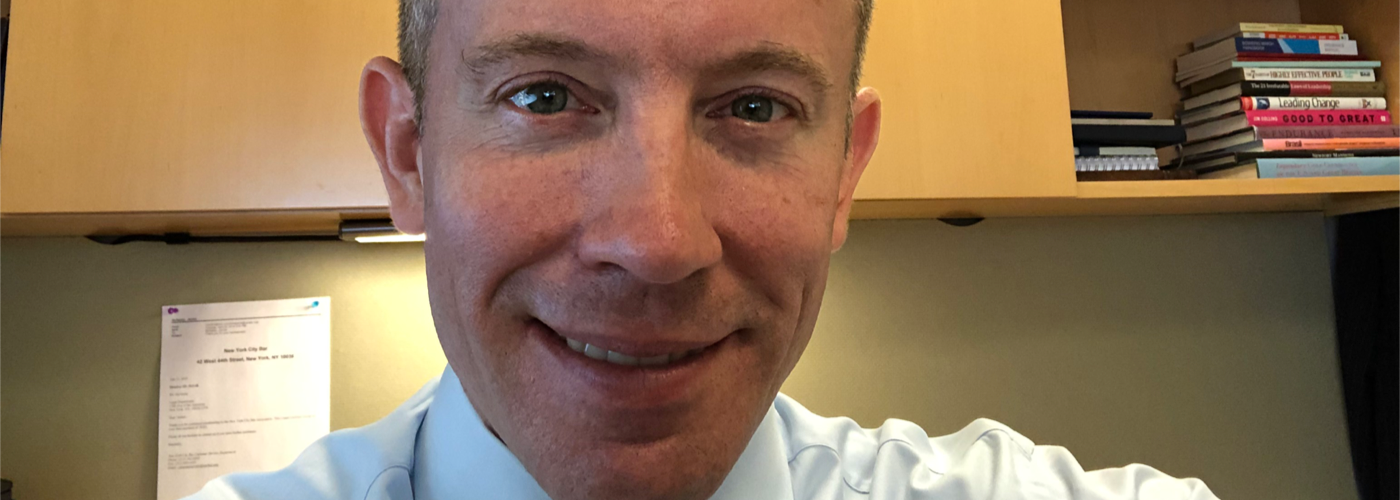NYC Attorney with Parkinson’s Describes Positive Effects of Deep Brain Stimulation

The first time the batteries for his deep brain stimulation (DBS) device were activated, Jim McNasby had the feeling a load burdening his body had been removed.
“It felt like a very gentle posture improvement; I just sat up straighter,” McNasby said in a phone interview, as he described how the technology has helped him. “It was like a weight was lifted and the shakiness in my limbs disappeared.”
McNasby, 50, a New York lawyer first diagnosed with Parkinson’s disease in 1999 at the age of 30, now wonders why he waited so long to have the DBS mechanism implanted.
“I wanted to be careful with brain surgery,” he said. “At the time it seemed so radical. But now I think: ‘Why didn’t I get it earlier?’”
DBS uses low-voltage electricity to stimulate specific parts of the brain via surgically implanted wires attached to a pacemaker-like neurostimulator placed under the skin on the upper chest. Doctors recommend the device mainly when Parkinson’s patients stop responding to medications designed to reduce motor symptoms, such as tremors, rigidity, involuntary movements, and walking problems.
The technology is not a cure. Research on its long-term effects is still limited, and scientists don’t know exactly how it works. However, a number of studies have shown that electrical stimulation of the subthalamic nucleus can improve symptoms, lower the need for medication, and improve the quality of life for people with Parkinson’s.
The Parkinson’s Disease News Today forums are a place to connect with other patients, share tips and talk about the latest research. Check them out today!
Stronger symptoms prompt decision
DBS also can ease symptoms of other diseases, including epilepsy and obsessive-compulsive disorder, and is being studied as a potential treatment for issues as wide-ranging as addiction, chronic pain, headaches, dementia, major depression, Huntington’s disease, multiple sclerosis, stroke, Tourette syndrome, and traumatic brain injury. Some 150,000 Parkinson’s patients had received DBS implants worldwide as of 2018.
In the past, McNasby relied on four medications to keep his symptoms under control. These included Sinemet (carbidopa/levodopa), which he was on for 16 years. In the spring of 2018, however, he started experiencing more tremors, shuffling, and asymmetrical walking. His “off-times,” when the medication wasn’t working optimally and motor symptoms returned, felt stronger and more frequent. Friends commented that he appeared to be struggling.
“I’d feel great, and then I’d fall off a cliff and hardly be able to walk,” he said. “I felt shaky and heavy and like I couldn’t balance. … I’d have to sit on my hands and that kind of stuff to try to stabilize.”
He and his doctor tried tweaking his medications, without much success. Then a friend suggested DBS.
The procedure has reversed his Parkinson’s symptoms by about 15 years, McNasby said, to around where they were when he was initially diagnosed. With round-the-clock electrical stimulation, he wakes up feeling good and no longer has drastic ups and downs during the course of the day.
“All the symptoms have been drastically reduced” and are “well within something that’s manageable,” he said.
“I feel so much better,” he added. “It’s something I unequivocally recommend.”
Voltage is easy to adjust
Several DBS devices are on the market, and different doctors follow different protocols to implant them. While McNasby said some patients have the whole system implanted over a 12-hour period, he and his team at Manhattan’s Mount Sinai Hospital chose a series of three surgeries over the course of about a month. His doctors selected Abbott’s Infinity™ DBS system with batteries that last 5-8 years before needing replacement rather than batteries that need daily recharging.
McNasby said he was initially nervous about the prospect of the surgery. His doctor explained the potential risks, which include an electrode placed in the wrong spot, stroke, speech complications, and unpredictable effects from the electricity. His first procedure was a magnetic resonance image (MRI) to pinpoint the exact locations in his brain for the implants.
The MRI was followed this past January by robotic surgery to insert a wire in his brain on the left frontal part of his head. The wire comes out through his skull and travels under his skin to a spot behind his left ear, then down his neck to a tiny battery placed on his chest below his collarbone. The stimulation from inserting the wire itself into his brain improved his symptoms for several days, making him more optimistic about the subsequent surgeries, he said.
The second surgery placed a wire and battery on the right side of his head and chest, and the third, on Feb. 11, connected the two sides to each other. After a three-week period of healing, and scaling down his Sinemet, doctors fully activated the device on March 5.
Today McNasby can barely see or feel the implanted wires and batteries. He likes the worry-free ease with which he and his doctor can adjust the voltage: he uses an Apple device the size of an iPhone that synchronizes with his batteries when he sets it on his chest, and his physician uses an iPad to determine the range of changes he can make. The day McNasby spoke to Parkinson’s News Today, one side of his brain was set at 2.5 volts and the other at 2.2 volts.
“You actually can’t hurt yourself with the device,” he said. “You can’t cause any damage that’s irreversible.”
Further improvement possible
And while he can’t feel the electricity while it’s stimulating his brain, he certainly can tell if it has been turned off: his symptoms come back immediately, “my tremors, especially,” he said.
Although McNasby said his case is not typical, he is now completely off the Sinemet. The only medication he uses is Amantadine, which he takes three times a day for tremors. Before his DBS implant, he had to take as many as 15 pills per day.
Despite developing Parkinson’s at an early age, McNasby says he feels very fortunate: his symptoms haven’t been worse, his disease progressed relatively slowly, and his response to DBS was strong. He never experienced the depression that often accompanies Parkinson’s.
He attributes his “luck” in large part to his one hour of exercise every day. He plays tennis, bikes, lifts weights, and does yoga.
McNasby said he and his doctor are still adjusting his electricity dosage, and it’s possible that he may feel even better in the future. After all, his DBS device has been operating for only two months and it has 44,000 settings.
He doesn’t want to get his hopes up too much. Still, he said, “44,000 [variations] – that’s a lot of options.”









